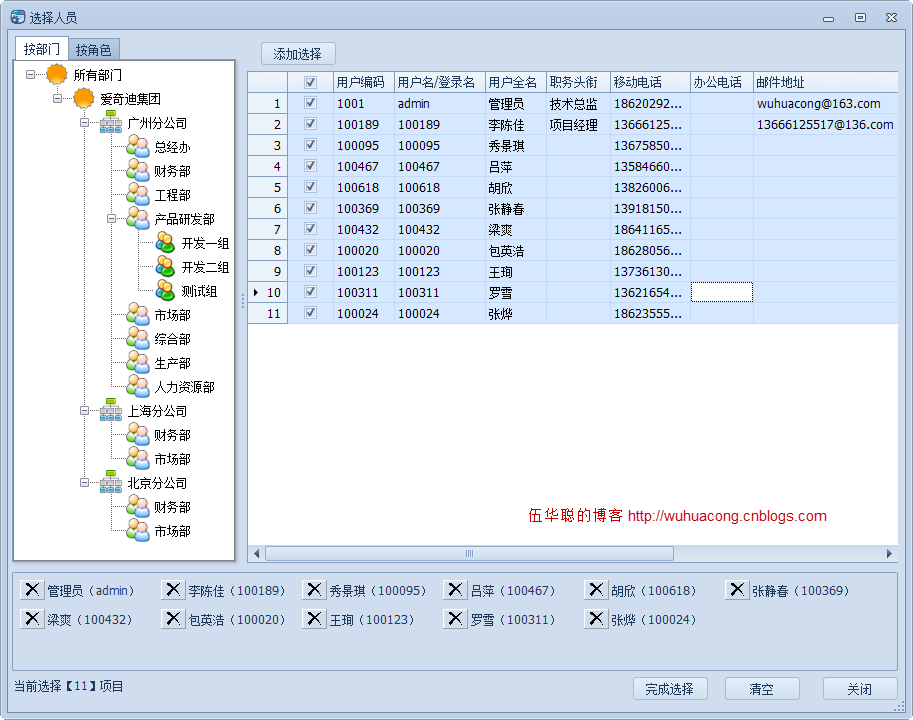Winform开发框架之权限管理系统改进的经验总结(2)-用户选择界面的设计
在上篇总结随笔《Winform开发框架之权限管理系统改进的经验总结(1)-TreeListLookupEdit控件的使用》介绍了权限管理模块的用户管理部分,其中主要介绍了其中的用户所属公司、所属部门、直属经理(人员列表)的几级数据级联的展示,通过引入TreeListLookupEdit控件,能增强用户的体验效果。本篇继续介绍权限系统模块中的一些闪光点,介绍组织机构管理里面选择用户的界面设计和实现,用户选择在很多场合会用到,如组织机构的用户选择,角色里面的用户选择,或者流程里面的用户选择等用途。
1、选择用户界面效果展示
用户选择在很多地方需要用到,本篇以组织机构里面的用户选择为例,介绍用户选择的界面效果。我们知道,用户一般可以按组织机构进行分类,也可以按照角色进行分类,因此我们需要结合两者进行快速展示用户的层次关系,界面效果如下所示。

在上面的界面分为三个部分:左边主要是机构和角色的展示;右边则是通过列表控件进行展示,并可以进行勾选的操作;底部则是已选用户的列表展示(可以移除)。
2、左边机构树的递归展现
组织机构本身设计就是一个有层次关系的树,因此它可以通过递归函数进行展现,展示方式可以使用传统样式的TreeView控件或者DevExpress样式的TreeList控件,不过我倾向于使用TreeView,觉得这个线状的层次关系更美观一些,递归展示结构树的代码如下所示。
private void InitDeptTree() { this.treeDept.BeginUpdate(); this.treeDept.Nodes.Clear(); TreeNode node = new TreeNode(); node.Text = "所有部门"; List<OUNodeInfo> list = BLLFactory<OU>.Instance.GetTree(); AddDept(list, node); this.treeDept.Nodes.Add(node); this.treeDept.ExpandAll(); this.treeDept.EndUpdate(); } private void AddDept(List<OUNodeInfo> list, TreeNode treeNode) { foreach (OUNodeInfo ouInfo in list) { TreeNode deptNode = new TreeNode(); deptNode.Text = ouInfo.Name; deptNode.Tag = ouInfo.ID; deptNode.ImageIndex = Portal.gc.GetImageIndex(ouInfo.Category); deptNode.SelectedImageIndex = Portal.gc.GetImageIndex(ouInfo.Category); treeNode.Nodes.Add(deptNode); AddDept(ouInfo.Children, deptNode); } }
角色树不是一个递归的关系,因此只需要按列表展示即可,展示代码如下所示。
private void InitRoleTree() { this.treeRole.BeginUpdate(); this.treeRole.Nodes.Clear(); TreeNode node = new TreeNode(); node.Text = "所有角色"; List<RoleInfo> list = BLLFactory<Role>.Instance.GetAll(); foreach (RoleInfo info in list) { TreeNode roleNode = new TreeNode(); roleNode.Text = info.Name; roleNode.Tag = info.ID; roleNode.ImageIndex = 5; roleNode.SelectedImageIndex = 5; node.Nodes.Add(roleNode); } this.treeRole.Nodes.Add(node); this.treeRole.ExpandAll(); this.treeRole.EndUpdate(); }
角色列表大概效果如下所示。

3、右边可勾选列表的实现
右边其实可以通过一般的GridView进行展示,但为了更好的封装和使用,我使用我的Winform分页控件中的WinGridview对象进行展示,这样使用起来更简便。
public partial class FrmSelectUser : BaseForm { public FrmSelectUser() { InitializeComponent(); this.winGridView1.ShowCheckBox = true; this.winGridView1.ShowExportButton = false; this.winGridView1.ShowLineNumber = true; this.winGridView1.BestFitColumnWith = false;//是否设置为自动调整宽度,false为不设置 this.winGridView1.OnRefresh += new EventHandler(winGridView1_OnRefresh); this.winGridView1.gridView1.DataSourceChanged += new EventHandler(gridView1_DataSourceChanged); if (!this.DesignMode) { InitDeptTree(); InitRoleTree(); } }
绑定数据是通过左边的树进行条件检索的,因此可以通过获取组织机构或者角色的节点数据进行查询,我们通过判断组织机构树节点或者角色树节点是否选中来判断即可,具体列表绑定的代码如下所示。
private void BindGridData() { List<UserInfo> list = new List<UserInfo>(); if (this.treeDept.SelectedNode != null && this.treeDept.SelectedNode.Tag != null) { int ouId = this.treeDept.SelectedNode.Tag.ToString().ToInt32(); list = BLLFactory<User>.Instance.FindByDept(ouId); } else if (this.treeRole.SelectedNode != null && this.treeRole.SelectedNode.Tag != null) { int roleId = this.treeRole.SelectedNode.Tag.ToString().ToInt32(); list = BLLFactory<User>.Instance.GetUsersByRole(roleId); } //entity this.winGridView1.DisplayColumns = "HandNo,Name,FullName,Title,MobilePhone,OfficePhone,Email,Gender,QQ,Note"; this.winGridView1.ColumnNameAlias = BLLFactory<User>.Instance.GetColumnNameAlias();//字段列显示名称转义 this.winGridView1.DataSource = new WHC.Pager.WinControl.SortableBindingList<UserInfo>(list); }
单用户勾选列表的复选框的时候,该行的数据会被选中,我们最后要获取用户的勾选记录(通过WinGridview控件的GetCheckedRows方法获取),然后获取对应的数据,添加到关联关系的数据库即可,具体代码如下所示。
private void btnAddUser_Click(object sender, EventArgs e) { List<int> list = this.winGridView1.GetCheckedRows(); foreach(int rowIndex in list) { string ID = this.winGridView1.GridView1.GetRowCellDisplayText(rowIndex, "ID"); string Name= this.winGridView1.GridView1.GetRowCellDisplayText(rowIndex, "Name"); string FullName = this.winGridView1.GridView1.GetRowCellDisplayText(rowIndex, "FullName"); string displayname = string.Format("{0}({1})", FullName, Name); if (!this.SelectUserDict.ContainsKey(ID)) { this.SelectUserDict.Add(ID, displayname); } } RefreshSelectItems(); }
4、用户选择结果的展示
在一些场景中,我们可能需要在多个组织机构和角色中选择不同的用户,为了更方便展示我们选中的记录,我设计了一个用户控件(一个删除按钮(Button)+标签控件(Lable))组合即可,如下所示。

由于我们选择的内容,无非就是选择它的人员名称即可,如果需要,单击删除按钮,让用户剔除不需要的人员,因此控件增加一个OnDeleteItem事件用来处理这个删除操作。
我们展示多个用户信息的时候,就是通过构造多个这样的控件,并动态增加到Panel里面即可,实现代码如下所示。
/// <summary> /// 刷新选择信息 /// </summary> private void RefreshSelectItems() { this.flowLayoutPanel1.Controls.Clear(); foreach (string key in SelectUserDict.Keys) { string info = SelectUserDict[key]; if (!string.IsNullOrEmpty(info)) { UserNameControl control = new UserNameControl(); control.BindData(key, info); control.OnDeleteItem += new UserNameControl.DeleteEventHandler(control_OnDeleteItem); this.flowLayoutPanel1.Controls.Add(control); } } this.lblItemCount.Text = string.Format("当前选择【{0}】项目", SelectUserDict.Keys.Count); }
5、最终的组织机构管理界面效果
在开篇说了,用户选择在很多场合会用到,如组织机构的用户选择,角色里面的用户选择,或者流程里面的用户选择等用途。
下面是组织机构里面的主体界面。

在右上角的包含用户区域,单击添加按钮,就会出现前面说到的用户选择对话框,如下所示。

 专注于代码生成工具、.Net/.NetCore 框架架构及软件开发,以及各种Vue.js的前端技术应用。著有Winform开发框架/混合式开发框架、微信开发框架、Bootstrap开发框架、ABP开发框架、SqlSugar开发框架等框架产品。
专注于代码生成工具、.Net/.NetCore 框架架构及软件开发,以及各种Vue.js的前端技术应用。著有Winform开发框架/混合式开发框架、微信开发框架、Bootstrap开发框架、ABP开发框架、SqlSugar开发框架等框架产品。
转载请注明出处:撰写人:伍华聪 http://www.iqidi.com






【推荐】国内首个AI IDE,深度理解中文开发场景,立即下载体验Trae
【推荐】编程新体验,更懂你的AI,立即体验豆包MarsCode编程助手
【推荐】抖音旗下AI助手豆包,你的智能百科全书,全免费不限次数
【推荐】轻量又高性能的 SSH 工具 IShell:AI 加持,快人一步
· 从 HTTP 原因短语缺失研究 HTTP/2 和 HTTP/3 的设计差异
· AI与.NET技术实操系列:向量存储与相似性搜索在 .NET 中的实现
· 基于Microsoft.Extensions.AI核心库实现RAG应用
· Linux系列:如何用heaptrack跟踪.NET程序的非托管内存泄露
· 开发者必知的日志记录最佳实践
· winform 绘制太阳,地球,月球 运作规律
· AI与.NET技术实操系列(五):向量存储与相似性搜索在 .NET 中的实现
· 超详细:普通电脑也行Windows部署deepseek R1训练数据并当服务器共享给他人
· 【硬核科普】Trae如何「偷看」你的代码?零基础破解AI编程运行原理
· 上周热点回顾(3.3-3.9)